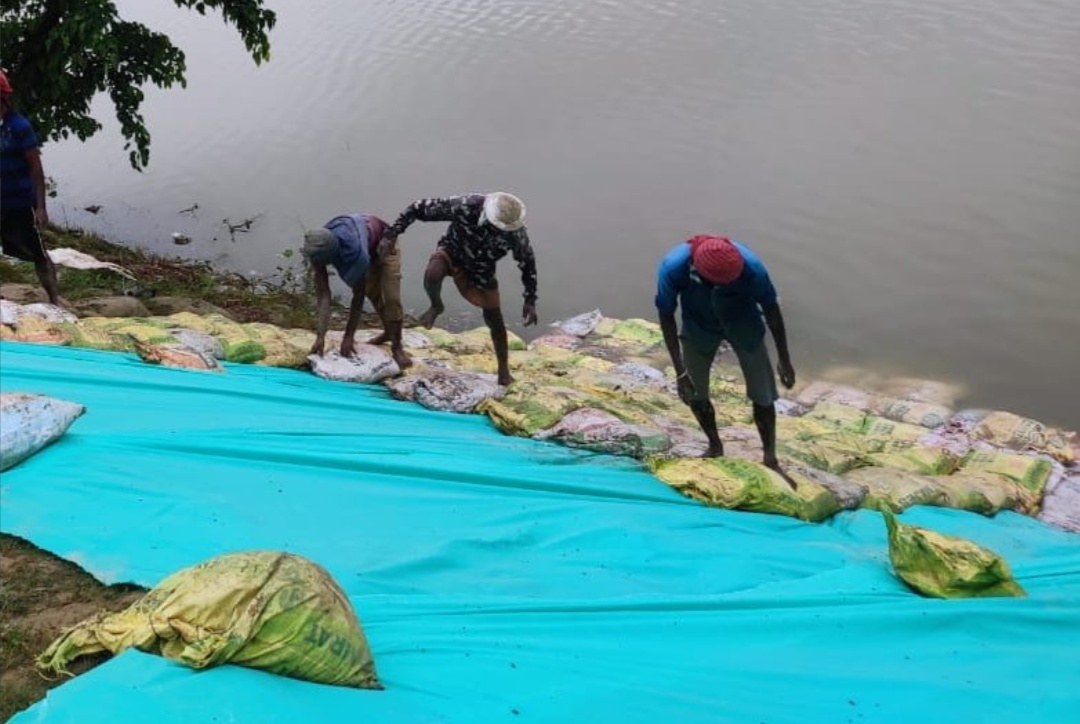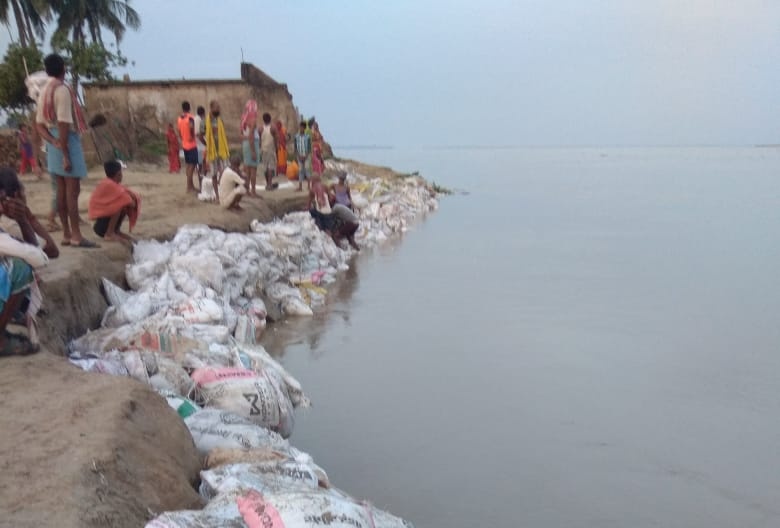Flood waters inundated the house of Ramchandra Yadav, a resident of Khoknaha village of Supaul, for three days. During these days he cooked food by setting up a brigade on the outpost and spent nights at the same post.
"The water level of the Kosi river was continuously rising, but there was no way to get out, so we decided to stay at home and made arrangements for cooking on the chowkis", Ramachandra informed.
For so many years, people living inside the Kosi embankment cook food using this jugaad as they are aware that no government help will be provided to them. Even this year, the story is no different. Despite the flood waters inundating people's houses, neither the government help nor any rescue boat reached for their aid and as a result, they had to spend three days within the flooded homes.
Ramachandra told India Water Portal,
“People living inside the Kosi embankment get little or no government help that is why we have been doing this jugaad for years during the flood season. After applying a thick coat of clay on the chowkis, it is covered with a sheet of tin on which food is cooked. A black stain, which appears due to cooking, is found on the chowkis of every house inside the embankment."
Every house built within the embankment has two to four chowkis so that the essential items can be saved from water at the time of floods and these chowkis also forms the place where people resort to when hit with floods.
Ramachandra says,
"In the past few days, the water level was somewhat low, but due to continuous rain it has started rising again and the danger of flooding looms once again."
This story is not just about Ramchandra. So far, 3,50,378 people have been affected by the floods in Bihar and almost everyone's story is the same in the region.
An official of the Disaster Management Department informed that 190 panchayats across eight districts of Bihar have been affected by the floods so far and 3,50,378 people have come under its impact. Out of these 13,535 people have been evacuated and sent to relief camps.
Several villages in Saharsa district were waterlogged in the past. However, when the rain stopped for some days, the water level got under control, but as the rains have started again, people are getting scared.
Chandraprabha Devi, the head of Aina Panchayat of Saharsa told India Water Portal,
“In the past few days, water had entered several houses, then it receded slowly, but now there is a possibility of flooding again.”
Last week of July experienced heavy rainfall
The districts of North Bihar have received heavy rainfall around July 21. According to the Indian Meteorological Department, Ramnagar and Chanpatia in West Champaran have recorded 290 mm of rainfall, while Jhanjharpur in Madhubani received 220 mm of rains on July 21. Similarly, 220 mm rainfall has been received in Sursand in Sitamarhi and 210 mm in Shivhar.
Anand Shankar, director in-charge of India Meteorological Department Patna, said, “The monsoon trough is moving towards Himalaya via Uttar Pradesh and Bhagalpur, which is causing heavy rains in North Bihar districts. He also said that the rains may continue in the same manner for the next 48 hours and thereafter it will decrease."
Minister of Water Resources Department Sanjay Jha said,
“Heavy rains have increased the river water level in many parts and we are closely monitoring the water level of various rivers.”
 The heavy rains on July 21 that continued for 24 hours considerably increased the water levels of Bagmati and Lakhandei rivers which caused inundation in many villages of Aurai, Katra and Gaighat blocks of Muzaffarpur. Nearly ten Chachari bridges made of bamboo have been damaged in the district, leading to traffic troubles in the areas.
The heavy rains on July 21 that continued for 24 hours considerably increased the water levels of Bagmati and Lakhandei rivers which caused inundation in many villages of Aurai, Katra and Gaighat blocks of Muzaffarpur. Nearly ten Chachari bridges made of bamboo have been damaged in the district, leading to traffic troubles in the areas.
About 41 thousand people have been affected by floods in Darbhanga. The flood water has entered 32 panchayats in the region. Similarly, in East Champaran, Sitamarhi, Gopalganj, Kishanganj etc., dozens of villages have been flooded due to the rising water level in the rivers.
Water discharge increased in Kosi and Gandak
On July 21, 3,35,425 cusecs of water was discharged from the Kosi Barrage. According to the officials from the Disaster Management Department, the water level in Kosi is continuously increasing. Moreover, 2 lakh 57 cusecs of water was discharged from the Kosi barrage on July 19 which implies that in total 60 thousand cusecs of water has been discharged from the river and there is a rapid rise in the river water flow.
The water level in Gandak is also rising constantly. At 6 am on July 21, 4,08,000 cusecs of water was discharged from Gandak Barrage, which increased to 4,36,500 cusecs at 10 am.
According to the Central Water Commission, the Mahananda River at Dhengraghat in Purnia is flowing above the danger mark while at Chargharia in Kishanganj it has almost touched the danger mark. The Gandak River has also touched the danger mark at Banka's Triveni. In Chitwan district, Nepal, the river is flowing 1.47 meters above the danger mark at Devghat. Similarly, the Adhwara River is flowing above the danger mark in Saharghat in West Champaran and its water level is continuously on the rise. The Kanakai River, a tributary of Mahananda, is flowing 1.7 meters above the danger mark at Naimchuli in Ilam, Nepal.
 In view of heavy rains, Bihar Chief Minister Nitish Kumar has instructed the district authorities to remain alert. He has ordered that action should be taken to evacuate people living in Gandak's catchment areas and also in the low-lying region. He has also given directions to provide masks to people and ensure social distancing norms are being followed in the relief camps.
In view of heavy rains, Bihar Chief Minister Nitish Kumar has instructed the district authorities to remain alert. He has ordered that action should be taken to evacuate people living in Gandak's catchment areas and also in the low-lying region. He has also given directions to provide masks to people and ensure social distancing norms are being followed in the relief camps.
Meanwhile, the Water Resources Department is receiving complaints of cracks, erosion in river embankments. On July 21 itself, half a dozen such complaints were received within 24 hours. In Parsauni village of Gopalganj, there was a complaint of erosion in the dam, which was repaired immediately.
A complaint of leakage was also received in Saran embankment in Saran district and immediate action was taken. An official from the Water Resources Department informed,
“The leakage was reported from the embankment at Tapua village in Bhagalpur, which was passed on to the local authorities and the repair work was carried out immediately. A similar complaint was also received regarding the embankment of Kamala Balan River. It has also been repaired.
Your cooperation
In case you notice any cracks or other problems in the embankments in your area, then call the helpline number 18003456145 and share the information immediately.
You can also report on Twitter by tagging #HelloWRD, @WRD_Bihar (Department of Water Resources). On obtaining the information, the department will immediately inform the officials of the concerned area and prompt action will be taken.
You can also share this information with India Water Portal via
Email | Facebook | Twitter | Instagram | Post to us
While sharing the information, please share your name, location, mobile number, email and photo. Your personal information will not be made public.
You can read the article in Hindi here. Authored by Umesh Kumar Ray; Translation to English by Swati Bansal













